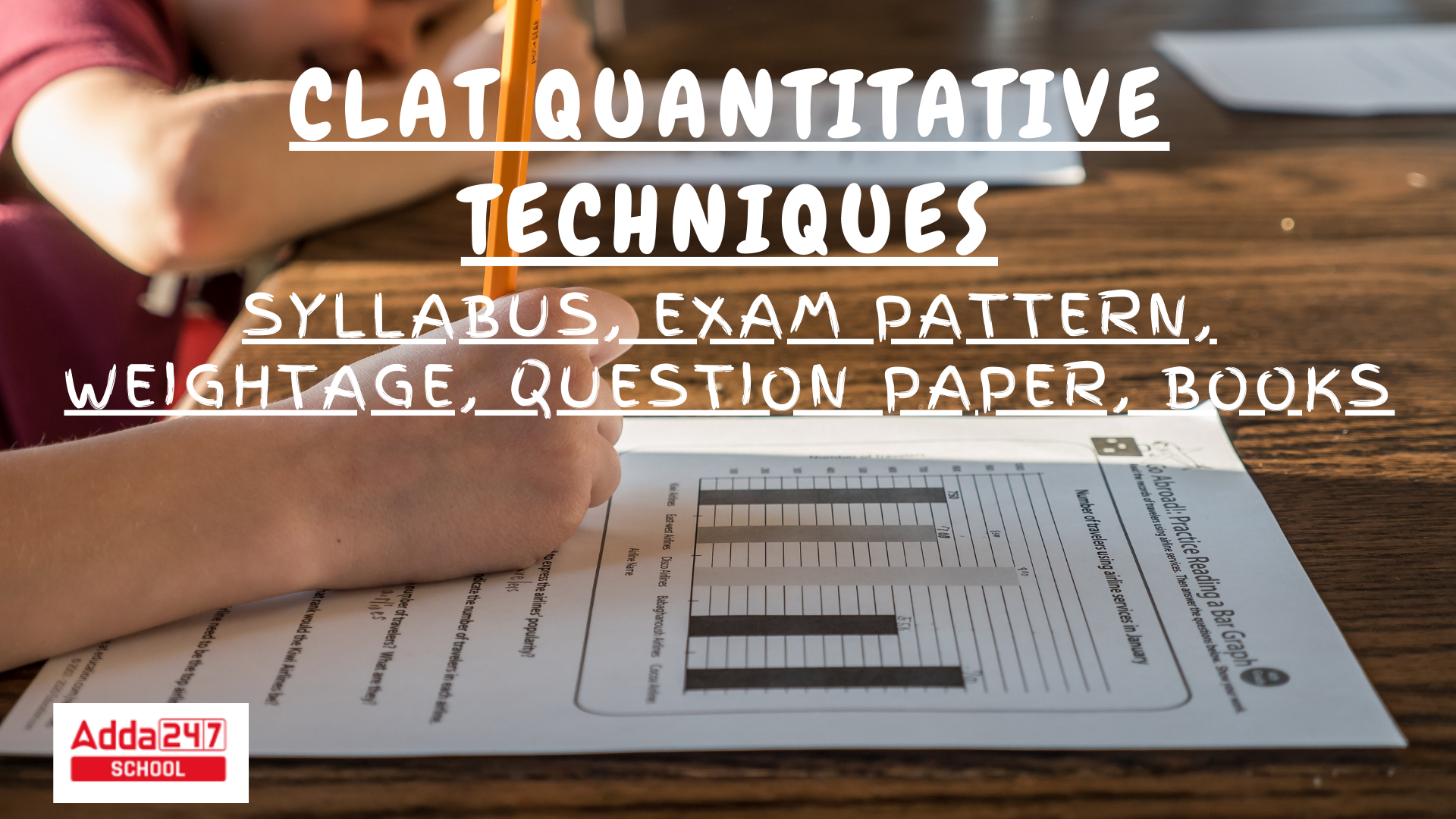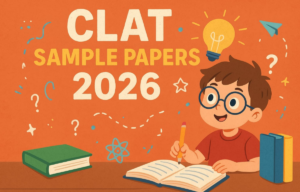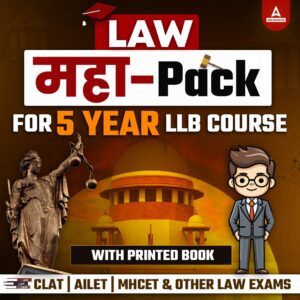The CLAT Quantitative Techniques Preparation method is required for success in the CLAT 2026 exam. Although the CLAT 2026 quantitative Techniques portion accounts for only 10% of the CLAT exam syllabus weightage, it might be a deciding factor for individuals seeking admission to the elite National Law Universities (NLUs). In this article, learn about the CLAT Quantitative Techniques Syllabus, exam pattern, weightage, the quantitative aptitude question paper, books, and some preparation advice.
CLAT Quantitative Techniques
The CLAT Quantitative Technique section appears to be the least difficult of the five CLAT 2026 sections. Because the questions are based on the Class 10 standard, students must remember all of the tactics if Mathematics wasn’t a subject they chose in Class 12. It is possible to score higher with an approach that strives to cover the subject while also providing ample mock exam practice. Although there may only be 13–17 questions on the CLAT 2026 Question Paper, applicants who prepare well will benefit from a 10% weighting.
CLAT Quantitative Techniques Paper Pattern
One cannot ruin their score in the Quantitative Techniques component of the CLAT exam by practicing insufficiently. The quantitative portion has 10-14 multiple-choice questions, accounting for about 10% of the total paper. Although the weightage provided to quantitative approaches for CLAT is smaller than the 20% weightage given to other areas, it is no less important. Have a look at the CLAT Quantitative Techniques paper pattern.
|
CLAT Quantitative Techniques Paper Pattern
|
|
| Weightage | 10% |
| Number of Questions | 10-14 MCQs |
| Marks | 10-14 |
| Negative Marking | -0.25 |
| Difficulty level | 10th standard |
CLAT Quantitative Techniques Syllabus 2026
Candidates can fill up any gaps in their CLAT Quantitative Techniques section preparation with persistent work, which will help them score highly. The following are essential topics in the CLAT 2026 maths portion.
- Basic Arithmetics: It is a branch of mathematics that encompasses basic operations such as addition, subtraction, division, and multiplication.
- Proportion and Ratio: determining the percentage increase or reduction, as well as the mathematical relationship between two provided scenarios
- Profit & Loss: This section deals with determining the gains or losses incurred in an activity.
- Mensuration is the study of measurement, volume, and geometry.
- Statistical estimation is the process of assessing and interpreting a given collection of data.
CLAT 2026 Quantitative Techniques Syllabus
| CLAT Quantitative Technique Syllabus | |
| Particulars | Details |
| Type of questions asked |
The section will include:
Short sets of facts or propositions Graphs Other textual material Pictorial or diagrammatic representations of numerical information These items will be followed by a series of questions |
| Question areas |
Number theory and basic arithmetic
Averages and Percentages Ratio and Proportion Mixtures and alligations Time and work Time, distance, and speed Fractions and equations Monetary evaluations Probability Permutation and combinations |
| Skills tested |
The section will test the candidate’s ability to:
Derive, infer, and manipulate numerical information Apply 10th standard mathematical operation, including ratios and proportions, basic algebra, mensuration, and statistical estimation. |
CLAT Quantitative Techniques Questions
The following CLAT Quantitative Techniques question is taken from the official UG-CLAT 2023 paper. Try it to determine your level of comfort in the segment.
Sample 1 – In 2000, one-eighth of the apples died, one-fifth of the remaining apples were sold to be juiced, and 30% of the remaining apples were exported. What number of apples were kept for home sale and consumption if the percentage proportion of oranges in 2000 was equivalent to the % share of apples in 2019?
(A) 39.2 million tonnes
(B) 1.6 million tonnes
(C) 16.8 million tonnes
(D) 2.7 million tonnes
A shopkeeper bought a book for ₹480 and sold it at a profit of 25%. At what price was the book sold?
Answer:
Selling Price = 480 × (125/100) = ₹600
Sample 2 – The ratio of boys to girls in a class is 3:2. If there are 45 students in total, how many girls are there?
Answer:
Total parts = 3 + 2 = 5
Girls = (2/5) × 45 = 18
Sample 3 – The average of five numbers is 36. If one of the numbers is 48, find the average of the remaining four numbers.
Answer:
Sum of 5 numbers = 36 × 5 = 180
Remaining sum = 180 – 48 = 132
Average = 132 ÷ 4 = 33
Sample 4 – A train covers 240 km in 4 hours. Find its speed in km/hr.
Answer:
Speed = Distance ÷ Time = 240 ÷ 4 = 60 km/hr
Sample 5 – Find the simple interest on ₹5000 at 8% per annum for 3 years.
Answer:
SI = (P × R × T) / 100 = (5000 × 8 × 3) / 100 = ₹1200
Sample 6 – A bag contains 5 red balls and 3 blue balls. One ball is drawn at random. What is the probability of getting a blue ball?
Answer:
P(E) = Favourable Outcomes / Total Outcomes = 3 / (5+3) = 3/8
Candidates should familiarise themselves with the CLAT paper pattern by practicing properly with the previous year’s CLAT question papers and CLAT sample question papers issued by the CNLU.
Click here to Practice – CLAT Previous Year Question Paper for 2023 PDF
Books for CLAT Quantitative Techniques
The quantitative portion of the CLAT 2026 will be of the tenth standard, so if you work hard, you can do well there. The key is to practice a lot, such as doing example papers and problem sets provided at the end of each chapter. Check the types of questions posed as well, and make sure you answer a lot of comparable ones. Candidates should read the following CLAT books to prepare for the Quantitative Techniques section:
- Class 10 NCERT book
- S Chand’s 30 Days Wonder for Maths
- Maths 18 Days Wonder by S Chand
- Quantitative Aptitude ebook (All Parts Solved) by RS Aggarwal
Preparation Tips for CLAT 2026 Quantitative Techniques
Candidates may struggle to get ready for the quantitative component of the CLAT. Still, it might not be as hard as it looks.
- The sheer nature of mathematics means that mastery of the subject demands constant practise.
- To tackle questions from the Quantitative Techniques portion, candidates must first brush up on their fundamentals. If candidates believe they lack conceptual clarity on any areas, they should use their Class 8 NCERT books to review their fundamentals.
- Candidates would find this portion easy if they stick to a study schedule and tackle enough CLAT quantitative aptitude sample papers and mock exams.
- To succeed in this section, candidates must also improve their reading and comprehension speed. The questions are frequently descriptive, and with great reading and comprehension skills, one can breeze through the portion rapidly.
- Throughout the exam, candidates must make sure that every calculation they perform is 100% accurate. Because there is a negative marking of 0.25 points, making stupid calculation errors can cost a lot of money.
- Comparably a few shortcuts and strategies for solving numerical problems can increase calculation speed and help you finish the part fast.









 CLAT Colleges 2026 List: Check Top Unive...
CLAT Colleges 2026 List: Check Top Unive...
 CLAT Sample Papers 2026 Released by Cons...
CLAT Sample Papers 2026 Released by Cons...
 Download CLAT Previous Year Question Pap...
Download CLAT Previous Year Question Pap...







